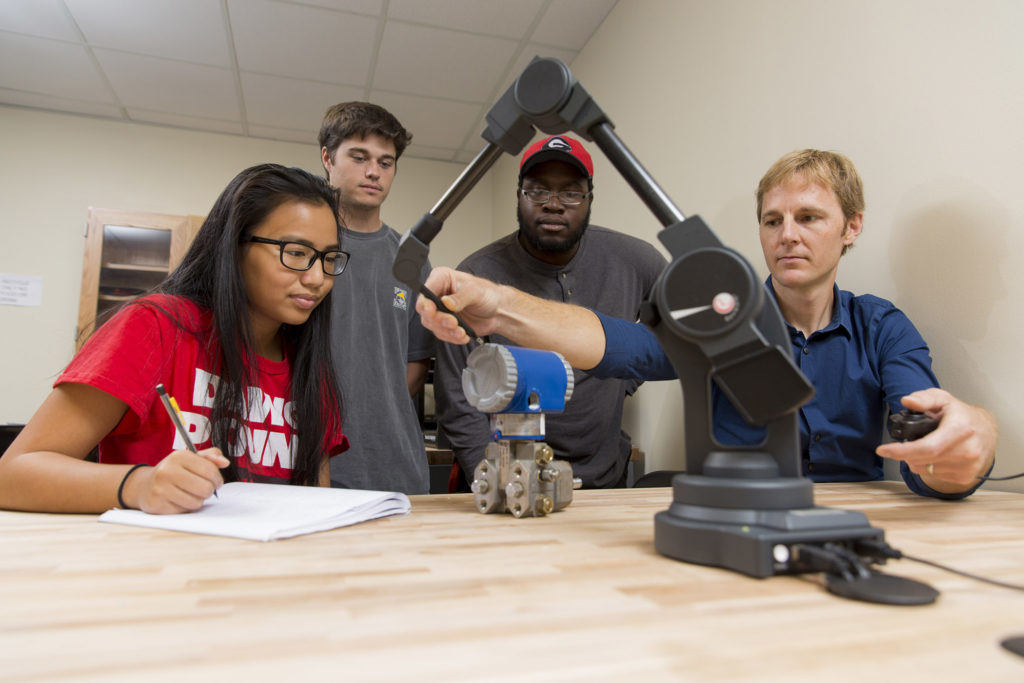A new interactive learning space in the UGA College of Engineering is designed to foster the type of collaborative spirit found in high-tech startups.
The Collaborative Design and Integration Studio features flexible work areas, a bank of 3-D printers, a 3-D plotter, a 3-D scanner and computers loaded with high-end graphics and design software. While college leaders say those tools are important, they believe the new studio’s defining feature is that it provides a place for students to work in teams on complex projects.
“Design is woven throughout our curriculum, so it’s vital for students to have a place where they can brainstorm, design a prototype, test their design and go back to the drawing board if necessary,” said Donald J. Leo, dean of the College of Engineering. “Our industry partners tell us they need engineers able to work in teams on open-ended projects, and the Collaborative Design and Integration Studio provides an environment for exactly that type of work.”
Located in former laboratory space in the Driftmier Engineering Center, the studio was designed with input from students and faculty. Many of the ideas students submitted through an online survey last spring made their way into the final plans, including work spaces that can be reconfigured for different groups and tasks. Renovation of the nearly 2,500-square-foot room began at the end of spring semester, and the college formally opened the new studio Aug. 19.
“We were careful not to strictly define the studio in a way that wasn’t adaptive to what the students wanted to do,” said Roger Hilten, an instructional research and support manager in the College of Engineering. “As time goes by, we hope the studio can evolve with the students and their needs.”
Administrators say students in the College of Engineering’s capstone senior design course are likely to be the biggest beneficiaries of the new studio. During the yearlong course, all fourth-year students work in small teams on an engineering challenge for clients that include industry, government agencies and nonprofit organizations. Recently, students have worked with Georgia Power to determine the optimal location for a new solar energy production site and with the U.S. Army to develop a line-of-sight texting device that doesn’t rely on cellular telephone service or satellites. In cooperation with UGA’s Archway Partnership, a public service and outreach unit, students have worked with communities across the state on civil engineering projects such as bridge rehabilitation, traffic assessment and design, and other infrastructure improvements.
Chris Turner, a senior from Augusta majoring in mechanical engineering, says he’s already seen the benefits of the studio.
Part of a senior design team working with Gulfstream Aerospace, Turner and his group recently used one of the new studio’s two conference cubicles for an online meeting with Gulfstream officials in Savannah.
“It was great to be able to share and discuss our slides and documents while interacting with our client in real time,” said Turner.
Ryan Foster agrees.
A senior biological engineering major from Atlanta, Foster says the studio is “definitely conducive to working in a group.”
As the College of Engineering grows—undergraduate enrollment topped 1,800 students this semester compared to fewer than 600 four years ago—administrators hope the Collaborative Design and Integration Studio is the first step in a long-term effort to provide students with state-of-the-art facilities that support design-oriented learning.
“With the right type of learning environments, we have an opportunity to link up with other colleges, schools and programs on campus to create a highly interdisciplinary experience for students,” said Leo. “I can envision engineering students working with students in nearly every other discipline at UGA on collaborative projects that positively impact the state.”
